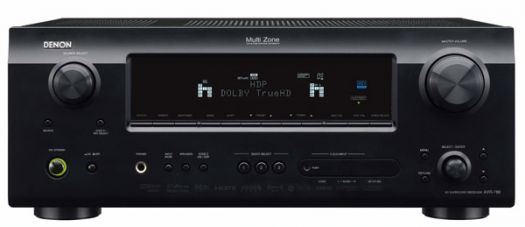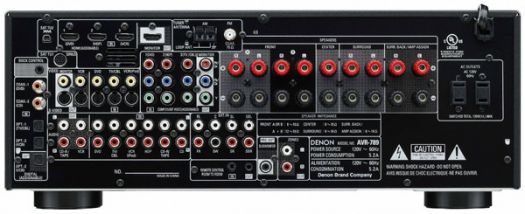Multi-Channel Movies and Music for the Masses
Thinking back to those heady days shortly before the turn of the millennium, I recall the unprecedented evolution from "good enough" VHS to downright impressive DVD and all of its marvels. These were the salad days for the Home Theater in a Box, as everyone wanted to go from mono to 5.1 in 30 seconds. A decade later, most Blu-ray adopters already have five speakers plus a subwoofer no doubt, in addition to a fine TV.
These folks can probably do just fine with the Dolby Digital or DTS options on their discs, but "just fine" seldom is, in actual fact. To unlock the latest high-definition audio formats, and manage an increasing number of HDMI devices, you're going to need a good home theater receiver. But with prices for Blu-ray players dropping faster than Grandma's knockers, does the latest audio decoding and video switching technology have to break the bank?
Hell no: As Chris Boylan pointed out in his enthusiastic review of the Onkyo TX-SR605, a well-featured receiver--this Swiss Army Knife of the CE world--is within the reach of just about any home theater buff. Now Denon proffers their high-value, high-versatility A/V receiver for the high-def age, the AVR-789, with its own unique array of inputs, outputs and processing.
What's It Got?
First off, the AVR-789 supports all of the audio codecs that a Blu-ray aficionado could hope for, including Dolby TrueHD 7.1 and DTS-HD Master Audio 7.1, backed by a respectable 90 watts for each of the seven channels. It can also send powered stereo to a second zone of the home, or if we do not use this feature we then have the option to bi-amplify the main speakers (left and right front channels) for superior performance. In fact, the rear-panel is a cornucopia for folks with multi-source or evolving gear stacks, backward-compatible all the way down to composite video, with ample S-video ports as well. Worth noting is the tribute the AVR-789 pays to bygone, lower-quality analog video formats, while at the same time eliminating the Phono input, even amid industry-wide claims of vinyl making a resurgence.

But wait, there's more: Beside the three HDMI 1.3a inputs is a single matching output, for the HDTV, and so all incoming video signals can be upconverted via the AVR-789's onboard Faroudja DCDi Video Processing and Scaling chip, specifically the FLI2310. This receiver also supports Sirius and XM satellite radio, with the addition of an antenna kit (and subscription) for either, sold separately.
The unit itself is stylish enough, with interesting design choices like enabling source selection via a large knob; instead of more traditional, individual buttons; opposite the volume knob. The RC-1099 remote control layout is, well... weird. In attempting to fill the role of a "universal" remote, it puts the buttons to operate various source components in the prime real estate, albeit in quirky locations, while being a lot stingier with the overall number of buttons than I'm used to on my go-to receiver. I was about to praise Denon for the clean, less-is-more approach until I discovered that the dedicated receiver controls are actually tucked away around back, hidden behind an awkward plastic door.
I found the menu system to be confusing, so much so that I needed to contact the manufacturer with a few questions during my initial setup, something I rarely do, but even the sparse manual offered few answers. Eventually I was able to configure my inputs, as well as adjust the HDMI output up to 1080p specifically, for the full HD effect, or so I hoped. The resolution of my varied input signals were readily, accurately recognized by the AVR-789.
How's It Look?
First up in my evaluations was the HQV Benchmark DVD, passed through the AVR-789 at 480i over component video (analog) on its way to 1080p upconverted output to the TV via HDMI. On the Color Bar test, the telltale tiny lines in the pattern were clearly visible and the color swatch transition was smooth, although not the smoothest ever. "Jaggies" Test 1 displayed more weird stair-stepping than I like to see on the single long rotating bar, while "Jaggies" Test 2 was a qualified "pass" as the top two lines had acceptably smooth edges, but the bottom one was a mess. In the "Jaggies" Flag clip, bricks were a mushy, ugly mess and the stripes of the flag were horribly blocky.

Testing next for Picture Detail, I noted that the key areas of the bridge, the grass and the statue were soft and vague, while Noise Reduction appeared to be non-existent. The Motion Adaptive Noise Reduction demo clips here were possibly the noisiest I have ever seen them. The Film Detail portion required maybe half a second before locking on and removing the moiré from the Super Speedway scene. Jaggies were problematic in several of the different Cadence, formats, although not as severe as I've ever seen when reviewing other components. Mixed 3:2 with Video Titles took a second to acquire, before displaying the horizontal and vertical scrolling text soft, but not fatally so.
Switching to the HD HQV Benchmark Blu-ray at 1080i over HDMI, I found the HD Noise Test to be buzzy, with unimpressive detail and the introduction of a bizarre motion artifacting. The AVR-789 fared better on the Video Resolution Loss Test, with fine horizontal black and white lines proudly displayed in the corners of the pattern. Performance on the Diagonal Filtering "Jaggies" Test was outstanding, as even the bottom line was acceptably smooth. The Film Resolution Loss Test revealed full-resolution processing, with dependably fine horizontal lines, no strobing and no vertical bands. Unfortunately, the Film Resolution Loss Stadium clip showed some eventual moiré in the upper deck. So overall, the handling of high-def content was superior to the upconversion of standard-def fare. Jaggies in particular were a struggle from SD signals, while well-managed in HD.
For an entry-level model, the Denon AVR-789 is remarkably flexible in its video settings. This can be confusing to the A/V newbie, but can be a great feature for those who take the time to research and experiment with the various video processing options. These include "Convert" (conversion of analog to digital video), "i/p Scaler" (de-interlacing of 480i and 1080i content to the maximum resolution of the display), "Resolution" (manual or automatic setting of output resolution) and "Progressive Mode" (automatic or manual settings for style of de-interlacing). These are settable on a per-input basis.
Because the receiver's on-board upconversion may be bettered by some external video processors or advanced displays, owners may want to bypass the receiver's video upconversion entirely for standard definition sources, passing the source through to the outboard processor or display at its original resolution. This way, a VCR connected using S-Video and a DVD player connected at 480i resolution via component video can be sent out to the display at 480i resolution over the HDMI output. To so this, simply set "Convert" to ON, "i/p Scaler to OFF and "Resolution" and "Progressive Mode" to AUTO. This way you can allow the receiver to do what it's best at - audio decoding over HDMI - but let the display device handle the video upconversion.
On Blu-ray movie playback, for which this receiver seems destined, video was rendered without compromise. There was no introduction of any new video anomalies on Blade Runner, which still impresses when presented properly, although the combination of modern digital restoration and old-school film elements require a delicate hand. The receiver also maintains the lush, pristine magnificence of Aurora et. al. when passing Sleeping Beauty, for a worthy presentation from start to finish.
How's It Sound?
For this review I used the Sony BDP-S350 as Blu-ray disc player, which offers bitstream output of the high-definition audio formats, DTS-HD Master Audio and Dolby TrueHD.
The AVR-789 in turn decodes and amplifies such soundtracks. With those 90 watts at its disposal for every channel, this receiver ably rocked all of my movie and music demos, with power to spare and without any significant distortion even at high volume. Its performance perpetuated the effortless power and precision I noted in my original review of The Incredible Hulk on Blu-ray, recreating one of the great recent DTS-HD Master Audio soundtracks in all its glory, from the mightiest crashes to the most gentle surround effects, with natural phasing between speakers. Switching to a less boisterous but still-demanding Dolby TrueHD disc, I popped in Risky Business specifically so that I could toggle between the Dolby Digital and Dolby TrueHD tracks. The music is stellar on this disc, and each time I stepped up to Dolby TrueHD, the fullness and clarity of the sound delivered by the AVR-789 was undeniable and thoroughly enjoyable.
The LED panel data during playback is a distinctive combination of logos, text and icons, depending upon what is being input and output at any given time. The source name and other pertinent info is displayed the largest and most prominently in block letters, while input signal (analog, digital) or decoder indicators (DTS-HD, Dolby TrueHD, etc.) light up above to indicate what the receiver is receiving or applying. When PCM signals are input, tiny rectangles representing the different channels appear on the lower left-hand side, while the channels being actively output to the speakers are marked with similar blocks at the lower right, each box bearing one- to three-letter abbreviations. This information was refreshed whenever I stepped through the various audio options on a disc.

Also onboard is a complement of additional audio processing options, by Audyssey Laboratories. Audyssey Dynamic Volume works a lot like Dolby Volume, at least in that it restrains overly-loud commercials and at the same time strives to maintain clear dialogue, while Audyssey Dynamic EQ assures adequate bass at lower overall volume levels. These can be used in tandem, although the effect imparted a somewhat artificial quality to the soundfield.
Audyssey MultEQ room correction was time well-spent however. Actually it took a mere six minutes for it to run through its speaker optimization mojo - I simply connected the included microphone (at the front panel jack on the receiver, behind a little pop-off panel that I lost more than once!), and positioned it in a half-dozen key spots as the AVR-789 sent out test tones to optimize its performance within my unique speaker/room relationship. The improvement, an attempt to make the gear and the room itself “disappear,” was subtle, an overall boost as if wringing out a bit more detail for a touch more realism. Bass management is done automatically when Audyssey is engaged, or it can be set manually in the Speaker Configuration section of the Setup menus.
Turn-Ons:
Turn-Offs:
Final Thoughts
Positioned as an entry-level receiver, the Denon AVR-789 is neither the most thoroughly equipped nor the least expensive, putting it somewhere in the middle of a growing field. It does offer the Denon pedigree however, evidenced by its terrific audio performance, so if the sound matters above all else, consider this affordable, versatile component.
Where to Buy:
User Manual:
Features/Specifications of the AVR-789:
Connectivity (Rear-Panel):
Manufacturer's Contact Information:
Denon Electronics (USA), LLC
100 Corporate Drive
Mahwah, NJ 07430-2041
201-762-6500
Web site: http://www.usa.denon.com/
| Overall | |
|---|---|
| Value | |
| Performance | |
| Features/Ergonomics |